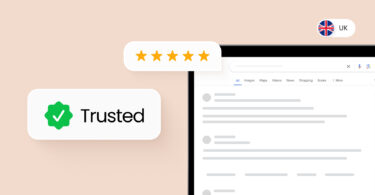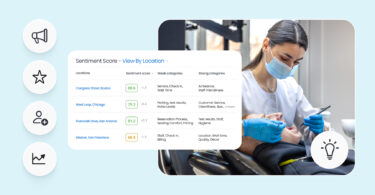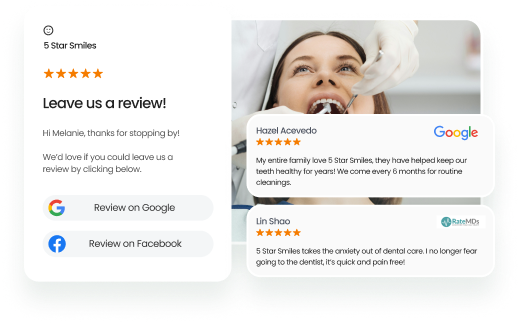Healthcare marketing analytics has become essential to modern healthcare strategies, guiding more precise, data-backed patient engagement and care approaches. In today’s dynamic healthcare environment, relying on traditional marketing methods is insufficient. Organizations must adopt advanced marketing analytics in healthcare to remain competitive and provide personalized experiences that truly connect with patients.
A striking example of this shift comes from Birdeye’s State of Online Reviews 2025, which reveals that 48% of healthcare review responses are now automated. This statistic underscores how AI tools reshape patient communication workflows, making interactions faster and more tailored. As automation becomes the norm, healthcare marketing analytics for healthcare is pivotal in elevating patient experiences through smarter, data-driven engagement.
This post explores the growing importance of healthcare marketing analytics in 2025, highlighting the latest platforms, strategies, and industry trends. We’ll also address organizations’ challenges and offer insights on navigating these hurdles to make the most of data-driven marketing.
Table of contents
- How healthcare segments are using analytics differently
- Key marketing analytics trends redefining healthcare
- Laying the groundwork for a modern marketing analytics strategy for a healthcare
- How to overcome healthcare marketing challenges with AI & Analytics
- Platforms shaping enterprise-level healthcare marketing analytics
- How Total Point Healthcare used Birdeye to boost patient engagement
- Reinvent your marketing with AI & analytics
- Frequently asked questions on healthcare marketing analytics
- How Birdeye helps healthcare organizations turn analytics into action
How healthcare segments are using analytics differently
Different parts of the healthcare industry use analytics based on their patient touchpoints, goals, and workflows.
Use cases by segment:
- Hospitals: Track appointment trends, discharge follow-ups, and campaign ROI
- Payers/Insurance: Analyze open enrollment behavior, policy engagement, and retention
- Pharma: Monitor prescriber activity, adherence programs, and patient education
- Telehealth platforms: Optimize virtual visit engagement and reduce no-shows
There’s no one-size-fits-all approach—analytics strategies must reflect each segment’s specific goals and patient journey.
Key marketing analytics trends redefining healthcare
2025 is transforming how healthcare marketers think about data. It’s no longer about collecting information for reporting—it’s about applying insights in real time to build stronger, more personalized, and compliant patient experiences.
These aren’t emerging trends anymore—they’re baseline expectations for healthcare brands that want to compete and connect.
1. AI-powered personalization and predictive targeting
Artificial intelligence is rapidly becoming the core engine behind healthcare marketing. At its core, this trend is powered by data collection, predictive analytics, and machine learning models that enable organizations to target, personalize, and optimize communication in real time. In 2025, here’s how healthcare organizations are using AI to turn analytics into action:
- Tailor communication to the individual: AI enables hyper-personalized messaging based on a patient’s historical data, such as health records, appointment history, digital behavior, and stated preferences. This shifts marketing from generic outreach to tailored patient journeys.
- Predict patient needs proactively: Using predictive analytics, marketers can anticipate what services a patient may need before the patient even realizes it. For example, AI might flag when a patient is due for a screening and could benefit from timely educational outreach and a call to action for scheduling.
- Drive automated decision-making: AI doesn’t just analyze—it also helps trigger the next best action, whether sending a follow-up email, recommending relevant content, or prompting a patient for outreach to care coordinators.
This way, AI ensures that your marketing is relevant and timely—an essential combination for improving patient outcomes and campaign ROI.
2. Data-driven content engagement: Interactive formats and short videos
Patients today expect digital content that is engaging, accessible, and easy to digest. As a result, healthcare marketers are using these formats not just to educate but to collect actionable engagement data that informs smarter campaigns.
- Short-form educational videos: Bite-sized clips (60–90 seconds) explaining procedures, coverage options, or treatment plans are highly effective for boosting comprehension. But beyond engagement, these videos also generate key metrics like watch time, drop-off rates, and CTA clicks that help marketers refine messaging and identify high-interest topics.
- Interactive tools: Health quizzes, decision calculators, and symptom simulators help patients actively participate in their care journey. Every interaction gives marketers valuable insights into user intent, preferences, and readiness to act. These insights can power follow-up campaigns, segmentation, or predictive scoring.
- Mobile-first delivery analytics: With more patients consuming content on their phones, performance data like load times, screen flow, and mobile-specific engagement are critical. Marketers use these insights to optimize healthcare content design, layout, and delivery, ensuring a frictionless, high-conversion experience on mobile devices.
Pro tip: Interactive and visual content also builds trust, improves understanding, and supports better health literacy, improving patient satisfaction and action.
3. Conversational analytics through generative AI and chatbots
Generative AI and conversational tools are expanding how healthcare organizations create content and connect with patients. These technologies help healthcare marketers scale content creation and automate patient interactions, all while generating granular analytics that inform strategy and improve outcomes.
Here’s how they’re reshaping marketing analytics:
- Chatbots for real-time assistance & data capture: Chatbots can now handle far more than appointment scheduling. In 2025, they answer FAQs, guide patients through onboarding, and even conduct post-visit check-ins, etc. Each interaction generates data on drop-off points, engagement patterns, and patient intent, offering a goldmine of insights for campaign optimization.
- AI-generated marketing content with performance tracking: Generative AI tools produce personalized newsletters, landing pages, and social content while adhering to regulatory guidelines. Marketers can track how these assets perform across channels, using analytics to refine tone, timing, and messaging strategy.
- Seamless integration with workflows: Modern chatbots and content engines or GenAI platforms are integrated directly with CRMs, EHRs, and care management platforms. This integration allows for dynamic, context-aware conversations for unified performance tracking.
These tools reduce manual work, scale outreach, and enhance patient support, especially outside business hours, making marketing more efficient and patient-friendly.
4. Privacy-first, HIPAA-compliant marketing
Healthcare marketers must build ethical, compliant, and transparent strategies in an age where data privacy is non-negotiable. Here’s how privacy-first marketing shapes the analytics landscape:
- Data use only with consent: Every patient’s data used in marketing must be collected with clear permission. Opt-ins, consent forms, and transparent disclosures are now central to any campaign. This directly affects what datasets can be leveraged in segmentation models and behavioral tracking.
- Full transparency and user control: Patients expect to know how their data is being used. Brands must openly communicate their privacy policies and offer easy ways for users to opt out or modify preferences.
- Vendor and platform accountability: Partnering with tools and platforms that sign Business Associate Agreements (BAAs) and offer robust encryption, audit trails, and breach protection is essential to staying compliant with HIPAA and other data protection regulations.
Pro tip: Privacy-first marketing is about more than compliance—building long-term trust with your patients and community.
Laying the groundwork for a modern marketing analytics strategy for a healthcare
To succeed in 2025, healthcare marketers must use a privacy-first, analytics-driven framework that empowers engagement, better outcomes, and full regulatory compliance. It’s about making data actionable, ethical, and aligned with the patient journey.
Steps to develop your analytics-driven healthcare marketing strategy:
- Set measurable goals (e.g., reduce no-shows by 15%, increase campaign CTR by 30%, or boost patient acquisition in a specific service line).
- Build patient personas with behavioral, demographic, and clinical data.
- Map content to the full patient journey—from awareness to post-care
- Use analytics to personalize video, email, and ad content to ensure it resonates with different patient segments.
- Integrate platforms like CRM, EHR, and marketing automation for seamless data flow.
A clear, integrated marketing strategy enables marketing teams to engage smarter while remaining secure and compliant.
How to overcome healthcare marketing challenges with AI & Analytics
Despite its benefits, healthcare marketing has challenges that must be addressed head-on.
Common obstacles:
- HIPAA compliance & data security – Non-compliance can result in penalties and reputational damage
- Digital divide – Not all patients have equal access to or comfort with technology
- Internal silos – Disconnected departments can block data sharing and campaign alignment
Solutions:
- Choose HIPAA-compliant platforms with secure data handling.
- Use analytics to identify underserved populations and tailor outreach accordingly.
- Encourage collaboration between IT, marketing, compliance, and care teams.
- Leverage AI to organize and interpret large volumes of data efficiently.
- Automate routine tasks—like appointment reminders or feedback requests—to ease the burden on lean teams.
Solving these barriers unlocks greater impact and builds stronger, safer patient connections.
Healthcare Marketing Analytics that Drive Growth
Want to see the impact of Birdeye on your business? Watch the Free Demo Now.
Platforms shaping enterprise-level healthcare marketing analytics
Modern marketing demands enterprise-grade analytics platforms tailored to healthcare’s unique challenges. These platforms integrate with EHRs, CRMs, telehealth, and advertising systems while remaining HIPAA-compliant.
Key capabilities include:
- Real-time dashboards and campaign performance metrics
- Attribution modeling across multiple touchpoints
- Integration with clinical and behavioral data sources
- HIPAA compliance and data security protocols
Popular platforms:
- Improvado – Customizable dashboards with strong compliance tools
- Tableau – Deep data visualization and integration potential
- CallRail – HIPAA-compliant call tracking and conversation intelligence
The right platform turns fragmented data into strategic insights that fuel more precise, effective, and compliant marketing.
How Total Point Healthcare used Birdeye to boost patient engagement
Total Point Healthcare, a multi-location ER and urgent care provider, leveraged Birdeye’s AI-powered platform to streamline review collection using QR codes, track patient sentiment, and respond quickly across 20+ facilities.
As a result, they increased their reviews by 486%, improved their Google rating to 4.6 stars, and drove over 62,000 profile impressions—proving how smart healthcare marketing can transform patient engagement at scale.
AI enables marketers to move from reactive communication to predictive, personalized engagement at scale.
Reinvent your marketing with AI & analytics
In 2025, healthcare marketing success will depend on your ability to turn data into meaningful connections. Patients expect timely, personalized communication; organizations must meet these demands while maintaining trust. By adopting HIPAA-compliant tools, using AI to enhance engagement, prioritizing transparency, and continuously optimizing with real-time data, you can build long-term, valuable relationships and ensure seamless compliance.
Frequently asked questions on healthcare marketing analytics
Healthcare marketing analytics involves tracking, measuring, and analyzing patient data and marketing performance to improve outreach, engagement, and ROI in healthcare campaigns.
It helps healthcare organizations personalize patient communication, optimize campaigns, and make data-driven decisions while complying with privacy laws.
It can be, as long as data is handled using secure platforms, patient consent is obtained, and vendors sign a Business Associate Agreement (BAA).
Popular tools include Birdeye, Improvado, Tableau, Google Analytics (with caution), and CallRail, all of which offer various levels of HIPAA compliance and integration features.
How Birdeye helps healthcare organizations turn analytics into action
In an increasingly competitive healthcare landscape, delivering timely, relevant, and personalized patient experiences is critical, and that starts with the right data.
Birdeye empowers healthcare organizations to harness the power of marketing analytics to improve patient communication, reputation, and engagement across every touchpoint.
Here’s how Birdeye supports healthcare marketers in 2025:
✅ Real-time patient feedback and sentiment analysis
Advanced AI tools now collect reviews, surveys, and patient feedback across multiple platforms, enabling healthcare providers to monitor satisfaction levels and identify service gaps. By analyzing real-time sentiment, organizations can quickly address concerns, improve care experiences, and fine-tune their marketing strategies to better align with patient expectations.
✅ AI-driven insights for smarter engagement
Using AI, Birdeye analyzes large volumes of feedback and interaction data to help providers understand trends and respond proactively to patient needs.
✅ HIPAA-compliant communication tools
From appointment reminders to follow-up messages, Birdeye ensures all automated outreach is secure, compliant, and customized, meeting marketing goals and regulatory standards.
✅ Reputation and listings management
Maintain accurate business listings and strengthen online visibility while monitoring and responding to reviews in one centralized dashboard.
✅ Unified platform to manage digital presence
Birdeye integrates reviews, messaging, web chat, and analytics into one easy-to-use platform—eliminating data silos and improving team efficiency.
✅ AI-powered chatbot for seamless patient interaction
Birdeye streamlines patient communication by offering instant, 24/7 responses for appointment scheduling, inquiries, and follow-ups. This automation enhances patient engagement while optimizing healthcare workflows.
Birdeye bridges the gap between healthcare data analytics and patient connection for more than 23,000+ healthcare providers. This gives marketing teams the insights they need and the tools to act on them responsibly and effectively.

Originally published









